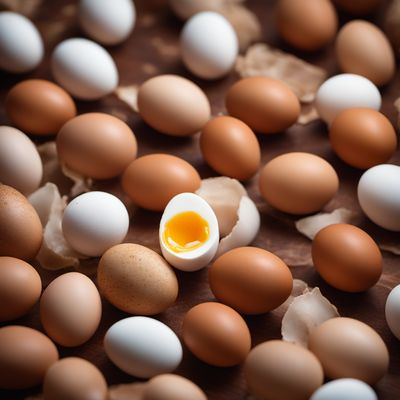
Ingredient
Egg mixed whole
The Versatile Powerhouse: Unleashing the Potential of Mixed Whole Eggs
Mixed whole eggs consist of both the egg white and yolk, offering a harmonious combination of flavors, textures, and nutrients. The egg white is translucent and viscous, with a gel-like consistency when cooked, while the yolk is vibrant yellow and creamy, lending a smooth and velvety mouthfeel. Together, they create a balanced taste and contribute to the overall richness of dishes.
Origins and history
Eggs have been consumed by humans for thousands of years, with evidence of their consumption dating back to ancient civilizations such as the Egyptians and Romans. They have been a staple in various cuisines worldwide, symbolizing fertility, rebirth, and new beginnings. Eggs have also played a significant role in religious and cultural traditions, such as Easter celebrations.
Nutritional information
Mixed whole eggs are a nutritional powerhouse, packed with essential nutrients such as protein, vitamins (A, D, E, and B vitamins), minerals (iron, zinc, and selenium), and healthy fats. They are also relatively low in calories, with one large egg containing around 70-80 calories.
Allergens
Eggs are a common allergen, and individuals with egg allergies should avoid consuming mixed whole eggs. It is important to read food labels carefully, as eggs can be present in various processed foods.
How to select
When selecting mixed whole eggs, choose ones that have a clean and uncracked shell. The eggs should feel heavy for their size and have a consistent shape. Avoid eggs with a strong odor or those that float in water, as these may indicate spoilage.
Storage recommendations
To maintain the freshness and quality of mixed whole eggs, store them in their original carton in the refrigerator, preferably in the main body of the fridge rather than the door. They should be consumed within 3-4 weeks of purchase.
How to produce
Amateur cooks can produce mixed whole eggs by simply whisking together the egg white and yolk until well combined. It is important to ensure proper hygiene and use fresh eggs for optimal results.
Preparation tips
Mixed whole eggs can be prepared in various ways, such as scrambled, fried, poached, or used as a binding agent in baking. To achieve fluffy scrambled eggs, whisk the eggs with a splash of milk or cream before cooking them over low heat. For a perfectly cooked fried egg, heat a non-stick pan with a little oil or butter and cook the egg until the white is set but the yolk is still runny. When using mixed whole eggs in baking, ensure they are at room temperature for better incorporation into the batter.
Culinary uses
Mixed whole eggs are a fundamental ingredient in numerous culinary applications. They are used as a base for omelets, quiches, custards, and frittatas, providing structure and richness. Mixed whole eggs are also essential in baking, acting as a binder, leavening agent, and adding moisture to cakes, cookies, and bread.
Availability
Mixed whole eggs are commonly available in grocery stores, supermarkets, and farmers markets worldwide.

